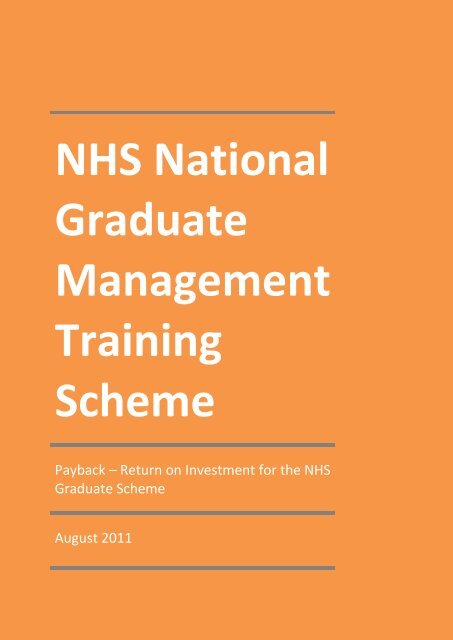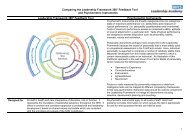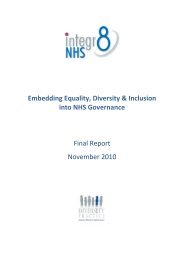NHS National Graduate Management Training Scheme
NHS National Graduate Management Training Scheme
NHS National Graduate Management Training Scheme
- No tags were found...
You also want an ePaper? Increase the reach of your titles
YUMPU automatically turns print PDFs into web optimized ePapers that Google loves.
<strong>NHS</strong> <strong>National</strong><strong>Graduate</strong><strong>Management</strong><strong>Training</strong><strong>Scheme</strong>Payback – Return on Investment for the <strong>NHS</strong><strong>Graduate</strong> <strong>Scheme</strong>August 2011Page | 1
IntroductionThe <strong>NHS</strong> <strong>Graduate</strong> <strong>Management</strong> <strong>Training</strong> <strong>Scheme</strong> is an established and awardwinning graduate programme which has been running in the <strong>NHS</strong> for over 50years. The broad aim of the <strong>Scheme</strong> is to provide the <strong>NHS</strong> with emergingleaders of a high standard and to ensure that there is a pipeline of talentwithin all areas of the service. In recent times the <strong>Scheme</strong> has concentratedon ensuring that trainees are focussed on the quality, innovation, productivityand prevention (QIPP) agenda. Split into four specialisms, the <strong>Scheme</strong> recruitsaround 150 trainees a year to work as part of a two-year programme in avariety of <strong>NHS</strong> organisations. The <strong>Scheme</strong> is run by the <strong>NHS</strong> Institute forInnovation and Improvement.It is fair to say that the <strong>Scheme</strong> has an excellent reputation with the traineeswho participate in the <strong>Scheme</strong> and within the wider graduate recruitmentarena. To date the <strong>Scheme</strong> has won many accolades that reinforce the highcalibre and success of the <strong>Scheme</strong>. These awards include: Currently rated 6 th in The Times Top 100 <strong>Graduate</strong> Recruiters Placed 7th in the Guardian Top 300 <strong>Graduate</strong> Employers 2010 Best New Provider of Work Experience in the <strong>National</strong> Placement &Internship Awards for 2011 Winner of the Diversity Award in CIPD’s Recruitment Marketing Awards2010 Highly Commended by CIMA in the ‘Large Employer’ category of itsannual awards November 2010.Three out of the four last <strong>NHS</strong> Chief Executives have been <strong>Graduate</strong> <strong>Scheme</strong>Alumni and both the 2010 and 2011 intakes of the <strong>Scheme</strong> attracted over12,000 applications from interested candidates.Despite all the accolades, the <strong>Scheme</strong> recently embarked on two ambitiouspieces of work centred around return on investment. In summary, the <strong>Scheme</strong>wanted to look in more depth at the value that the <strong>Scheme</strong> brings to the <strong>NHS</strong>.It is widely acknowledged that graduate trainees and graduate <strong>Scheme</strong>sgenerate a return on investment for the organisation or business. Forexample, Dr Anthony Hesketh of Lancaster University’s <strong>Management</strong>Page | 3
School 1 revealed that the business case for graduate recruitmentprogrammes is as strong as ever, at a time when economic uncertaintyhas led to many organisations adopting limited graduate recruitmentstrategies. With this in mind the <strong>Scheme</strong> looked to complete two keyROI-related projects to look at the impacts trainees make both on the<strong>Scheme</strong> and as alumni.The first piece of work looked at implementing a system that would accuratelytrack the progress of all trainees who start on the <strong>Scheme</strong>, something thatwould give statistical return on investment evidence. The <strong>NHS</strong> is a large andcomplex organisation and trainees have previously left the <strong>Scheme</strong> every yearto work for hundreds of different <strong>NHS</strong> organisations, all previously with theirown HR and payroll systems. The <strong>Scheme</strong> has always kept up to date withalumni through newsletters and optional databases but a statistical analysis ofalumni has never been a realistic possibility due to the fragmented structure ofthe <strong>NHS</strong>. With the introduction of the <strong>National</strong> Electronic Staff Record (ESR)system, an opportunity presented itself for the <strong>Scheme</strong> to look at doing anaccurate statistical analysis of previous trainees. A partnership with ESR wasset up and the <strong>Scheme</strong> intake years from 2003 to 2008 were analysed to makeup the first half of this report. Data protection standards were followed at alltimes and the <strong>Scheme</strong> is only able to report on anonymous data, not on anyindividual employee. But this piece of work has enabled the <strong>Scheme</strong> to look atproducing information around retention rates, salary, career progression andregional information for the first time. Due to a high number of individuals notstating their ethnic origin for the ESR system we are unable to provide robustBME data. This report presents statistical information and provides somecomparison to other graduate recruiting organisations in Chapter 1.The second piece of work looked at the return on investment of trainees whilston the <strong>Scheme</strong>. It is obviously easier to identify the work that trainees dowhilst on the <strong>Scheme</strong> compared to when they leave but it is more of achallenge to produce a robust, standardised approach to calculating how thiswork supports the QIPP agenda, benefits patients and articulates how traineesgenerate a return on the investment made in them by the <strong>Scheme</strong>. Work hasbeen carried out with a pilot group of current trainees to collect informationabout their placement work to try and calculate a ROI figure for this work andthen to project the impact of this work over the length of the placement. Theconcept of ROI, underpinned by QIPP, has been embedded in the <strong>Scheme</strong> so1 Hesketh, Anthony Dr, Adding Value Beyond Measure, the Business Case for <strong>Graduate</strong> RecruitmentProgrammes, 2004,Page | 4
that trainees are required to think about how they are generating a return onthe investment made in them by the <strong>Scheme</strong> and how their work supportsQIPP and ultimately benefits patients. This work is explained in more detail inChapter 2.The <strong>Scheme</strong> is committed to assessing how each of its trainees and alumni addvalue to the <strong>NHS</strong> both whilst on the <strong>Scheme</strong> and in their future careers. Alltrainees are now expected to complete a standardised template to capture ROIin their placements and we will continue to monitor their career progressionthrough the use of ESR outlined below. This continual gathering of informationwill enable the <strong>Scheme</strong> to continue to showcase and spread best practiceamongst its trainees and will allow the <strong>Scheme</strong> to provide robust evidence forcontinuing improvement in patient care and Return on Investment.Providing a backdrop to the <strong>NHS</strong> return on investment workEvery year the Association of <strong>Graduate</strong> Recruiters (AGR) carries out a largesurvey of all the UK’s main graduate recruiters 2 . In 2011 over 200organisations took part with the response list reading like a ‘who’s who’ of thewell-known organisations operating in the UK and it is this report that providesus with a useful backdrop to the work the <strong>NHS</strong> has carried out.Assessing the success of graduate programmes, both whilst trainees are on theprogrammes and once they attain their first post-programme role, is clearly adifficult issue for organisations. The AGR report provides over 60 detailedpages of statistical information largely based around vacancies, salaries,application data and retention rates. It is perhaps a telling sign that the trickysubject of assessing the success of graduate programmes takes up just onepage towards the back of the report and is not covered in much detail. Thereasons for this are clear. The instinctive feeling from most organisations isthat employing the best possible graduate talent as part of a programme andthen developing them can only be a positive thing for the organisation. Buthow does one go about accurately assess the impact and success of theprogramme?The AGR survey firstly reveals that 20% of organisations do not currently doany assessment whatsoever of the outcomes of their graduate programmes,but at least this is an improvement on 2008 when 30% of organisations2 Association of <strong>Graduate</strong> Recruiters 2011 review, http://www.agr.org.uk/Default.aspxPage | 5
eported the same thing 3 . Of the remaining 80% of organisations who doattempt to measure the success of their graduate programmes it is largelystatistical methods that seem to be used. Measuring retention rates is clearlythe primary method of measuring success, with 89% of organisations whoassess their programmes stating that this is their most common method ofmeasurement. 85% use formal feedback from managers and 75% survey thegraduates themselves. Other measures of success include tracking thegraduate’s progression through the organisation (71% of organisations do this)and further qualifications attained by graduates (55%).Lastly, a surprising statistic is that according to the AGR report around threequarters of graduate recruiters surveyed do not do any assessment of thefinancial returns on their investment in their graduate programmes. This isessentially saying that three quarters of the UK’s main organisations do notfinancially assess whether their graduate programmes are worth the money.Retention ratesThe AGR report paints an interesting picture of today’s graduate market interms of retention. It is clear that the days when a graduate joins a companyfrom university and opts to stay for the bulk of their career are well and trulyover. The survey found that only 46% of organisations manage to retain all oftheir graduates during the first 12 months of employing a new cohort and just8% of organisations report that they have retained all of their graduatetrainees after 36 months. When looking at retention rates the AGR found thaton average around 10% of graduates leave their company during the first year,20% leave during the first three years and 35% leave during the first five years.3 Association of <strong>Graduate</strong> Recruiters 2008 review, http://www.agr.org.uk/Default.aspxPage | 6
The chart above, although somewhat complex, displays some stark themes. Itshows that just over a quarter of graduate recruiting organisations lose overhalf of their graduate intake within five years. One in ten organisations loseover half of their graduate intake within three years. The message appears tobe clear: Generation Y generally does not see themselves working for the sameorganisation for a decade, let alone a lifetime. However, the good news is thatthe <strong>NHS</strong> compares favourably to these statistics and retention rates to the <strong>NHS</strong>from the <strong>Scheme</strong> are looked at in more detail in Chapter 1.The survey also found that three quarters of graduates are employed onpermanent contracts within their organisation. The <strong>NHS</strong> <strong>Graduate</strong> <strong>Scheme</strong>employs all <strong>NHS</strong> trainees on 24 month or 31 month fixed-term contractsdepending on their specialism. This creates a ‘decision point’ for <strong>NHS</strong> traineescoming to the end of the <strong>Scheme</strong> where a decision is required whether to stayin the <strong>NHS</strong> or move on to other organisations. The figures in this report showthat not only do <strong>NHS</strong> trainees overwhelmingly opt to stay in the <strong>NHS</strong>, they doso at a higher rate than the average graduate retention rates found by AGR.Page | 7
Chapter 1Quantitative ROI – A Statistical Analysisof <strong>Scheme</strong> AlumniWe know that trainees do not just add value when they are on the <strong>Scheme</strong>;they continue to add value as they progress in their <strong>NHS</strong> careers. Anecdotally,we have known that trainees move into <strong>NHS</strong> jobs and tend to stay in the <strong>NHS</strong>.At a local level, Alumni continue to support the <strong>Scheme</strong> by hosting placementsfor trainees, and supporting the recruitment and assessment process . The<strong>Scheme</strong> communicates with alumni via network meetings, an alumni websiteand <strong>Scheme</strong> meetings.As detailed in the introduction, a statistical analysis of alumni was carried outin early 2011 to look at quantitative information relating to trainees once theyfinish the <strong>Scheme</strong>. The report looked at over one thousand trainees from the<strong>Scheme</strong> intakes of 2003, 2004, 2005, 2006, 2007 and 2008. Further detailsabout the process and analysis can be found by contacting the report authors(contact details on page 36).This data analysis allows us to start to give answers to the following questions:What is the retention rate of the <strong>Scheme</strong> to the <strong>NHS</strong>? How does this retentionrate compare with other graduate recruiting organisations? Does oneparticular <strong>Scheme</strong> specialism retain more trainees than another? What salariesdo trainees earn post-<strong>Scheme</strong>? What is the average banding of trainees after acertain period post-<strong>Scheme</strong>?This chapter attempts to give answer the questions above based oninformation from trainees who were on the <strong>Scheme</strong> between 2003 and 2008.Page | 8
Retention RatesAs referenced in the introduction to this report, according to the Association of<strong>Graduate</strong> Recruiters (AGR) 80% of graduate recruiting organisations who doattempt to measure the success of their graduate programmes, retention ratesare by far the most common measurement method employed.In 2011 the AGR conducted a major graduate survey of more than 200graduate employers 4 . They found that average one year retention rates stoodat 93%, three year retention rates stood at 79% and five year retention ratesstood at 64%.Average retention rates for graduate employers over one, three and five yearsFive-year retention-rate64%Three year retention-rate79%One year retention-rate93%Source: AGR <strong>Graduate</strong> Recruitment Survey (2011)The 2008 AGR report found that only 44% of organisations surveyed werehappy with their retention rates and that the other 56% of organisations feltthat they needed to work to retain a ‘few more’ or ‘many more’ of theirgraduates. Clearly this is an issue organisations seem to struggle with.4 Association of <strong>Graduate</strong> Recruiters , http://www.agr.org.uk/Default.aspxPage | 9
Retention rates by SHA regionThe data on retention rates can be split further by SHA region. To be clear, thissection looks at retention rates to the <strong>NHS</strong> as a whole by SHA region. So forexample, 80% of trainees who were in the North West as part of the 2005<strong>Graduate</strong> Intake are still working in the <strong>NHS</strong>. Some will still be working in theNW SHA region; others may be working in other SHA regions.The following table shows retention rates to the <strong>NHS</strong> by region and by intakeyear:Region 2008 2007 2006 2005 2004 2003East Midlands 79% 81% 85% 56% 88% 58%East of England 88% 65% 80% 56% 77% 46%London 74% 74% 69% 60% 48% 43%North East 83% 93% 72% 80% 58% 73%North West 90% 82% 67% 80% 69% 73%South Central 92% 79% 77% 69% 50% 73%South East 87% 71% 77% 43% 56% 58%South West 81% 75% 70% 92% 53% 85%West Midlands 88% 80% 64% 67% 71% 54%Yorks & Humber 89% 75% 79% 81% 79% 60%Page | 11
The following chart looks at retention rate by SHA in a different way and totalsup all the trainees who have taken part in the <strong>Scheme</strong> between 2003 and2008. It then looks at the total percentage that are still working in the <strong>NHS</strong>.100.0%90.0%80.0%70.0%60.0%50.0%40.0%30.0%20.0%10.0%76.3% 75.6% 75.3% 74.5% 74.0%69.2% 67.1% 65.5%60.9% 59.6%0.0%NorthEastEast YorkshireMidlands andHumberNorthWestSouthWestSouthCentralWestMidlandsEast ofEnglandSouthEastLondonThe chart shows a fairly even percentage rate, but it’s interesting to note thattrainees who trained in London and the South East are slightly more likely toleave the <strong>NHS</strong> compared to other regions, presumably due to the abundanceof other graduate recruiting companies within these areas.Page | 12
Overall retention rates by intake year and specialismOverall Retention Rates by Intake Year and Specialism100%90%80%70%60%50%40%30%91%87%81%79%76% 77% 79%70%73%65% 64%61%70%66% 66%39%52%GeneralHumanFinance20%10%0%2008 (2years)2007 (3years)2006 (4years)2005 (5years)2004 (6years)2003 (7years)The chart above shows that, with at least the past five years’ worth of intakes,there isn’t any direct correlation between chosen specialism and retention rateto the <strong>NHS</strong>. Only 39% of 2004 HR trainees remain in the <strong>NHS</strong> at the currenttime, but this is perhaps because this was the first intake, and was only 20trainees. The HR <strong>Scheme</strong> started in 2004, so there is no data for 2003.Page | 13
Overall retention rates by gender100%90%80%70%60%50%40%30%20%10%0%77% 75%FemaleMaleThe chart above shows the overall percentage of trainees from 2003 to 2008who have stayed in the <strong>NHS</strong> by gender. The chart shows an even percentagerate between male and female.Page | 14
FinanceFinanceGeneralGeneralHRHRFinanceFinanceGeneralGeneralHRHRFinanceFinanceGeneralGeneralHRHRRetention rates – full breakdown by region, specialism and year2003 2004 2005East Midlands 50% 67% N/A 100% 100% 33% 57% 56% 50%East of England 75% 33% N/A 80% 86% 0% 43% 71% 50%London 20% 56% N/A 57% 41% 67% 50% 65% 60%North East 25% 100% N/A 67% 63% 0% 89% 78% 50%North West 75% 71% N/A 86% 50% 100% 75% 89% 67%South Central 100% 67% N/A 67% 50% 0% 40% 100% 50%South East 50% 67% N/A 40% 70% 0% 60% 29% 50%South West 83% 86% N/A 80% 50% 0% 100% 86% 100%West Midlands 57% 50% N/A 25% 89% 100% 50% 75% 67%Yorks & Humber 29% 88% N/A 83% 80% 67% 80% 89% 50%2006 2007 2008East Midlands 80% 88% 80% 50% 88% 83% 75% 100% 60%East of England 71% 75% 100% 71% 75% 40% 100% 86% 83%London 82% 56% 67% 64% 71% 89% 67% 71% 86%North East 67% 71% 80% 75% 100% 100% 100% 86% 60%North West 63% 50% 100% 71% 89% 83% 100% 100% 78%South Central 50% 88% 100% 80% 67% 100% 100% 88% 100%South East 50% 100% 67% 100% 60% 50% 100% 83% 83%South West 60% 78% 67% 50% 75% 100% 100% 90% 50%West Midlands 29% 89% 67% 50% 86% 83% 80% 100% 75%Yorks & Humber 83% 67% 100% 71% 100% 40% 100% 88% 83%The tables above show individual retention rates by intake year, region andspecialism. For example, 86% of General <strong>Management</strong> trainees who wereplaced in East Midlands in 2004 are still working for the <strong>NHS</strong>. It should benoted that some of these sample sizes are very small and therefore thepercentages shown shouldn’t be used for trend analysis.Page | 15
Organisation TypesThe following section contains information about the types of organisationsthat trainees from the 2003 to 2008 intake (and still working in the <strong>NHS</strong>) arenow working for.Organisation type - overall54.0%28.5%7.6% 6.8%2.4%0.8%Acute / FTPrimary CareTrustSpecial HealthAuthorityMental HealthStrategicHealthAuthorityAmbulanceThe chart above shows the overall breakdown of the types of organisationswhere trainees from the 2003 to 2008 intakes are currently working within the<strong>NHS</strong>.Page | 16
Organisation type by specialism56.4%52.0%50.7%34.9%Finance20.9%23.3%17.3%GeneralHR13.0%3.9%2.1%0.9% 0.3%7.6%2.4%6.2%4.8%2.1%1.3%Acute Ambulance Mental Health Primary CareTrustSpecial HealthAuthorityStrategicHealthAuthorityThe chart above shows the breakdown of the types of organisations wheretrainees from the 2003 to 2008 intakes are currently working within the <strong>NHS</strong>broken down by specialism.Page | 17
Salary and BandingAverage salary by intake year£50,420£48,328£45,419£39,873£36,435£33,9022003 Intake 2004 Intake 2005 Intake 2006 Intake 2007 Intake 2008 IntakeThe chart above shows the breakdown of average salary for trainees from the2003 to 2008 intakes (excluding Finance 2008 trainees) who are currentlyworking within the <strong>NHS</strong>, broken down by intake year. The chart gives anindication of what trainees may expect to earn post-<strong>Scheme</strong>.For example, 2008 General <strong>Management</strong> and Human Resources trainees haverecently left the <strong>Scheme</strong> for their first jobs in 2010 and the ones who remainedin the <strong>NHS</strong> are earning an average salary of £33,902. As a second example, the2004 trainees left the <strong>Scheme</strong> in 2006 and now have four years post-<strong>Scheme</strong>experience. Their average salary is £48,328.Page | 18
High achieversThe previous section looks at average salaries of our recent alumni, but whatabout the ‘high achievers’? There are many ways to assess what constitutes ahigh achieving individual but salary is generally accepted as one of the morereliable measures of progression. One could argue that higher salaries areattached to more senior roles and by attaining a higher salary our alumni havemoved in to a more senior position. We looked at the top 10% earners of eachintake year and looked at the salaries they were earning.The top 10% of earners who have around five years post-<strong>Scheme</strong> experience(2003/4 intake) are earning between £66,000 and £96,000 indicating that theyare likely to be working in Head, Assistant Director or Director roles (orequivalent). From this we could conclude that of the <strong>NHS</strong> trainees who stay inthe <strong>NHS</strong> post-<strong>Scheme</strong>, 10% of them reach these senior roles within around fiveyears of leaving the <strong>Scheme</strong>.The top 10% of earners who have around three years post-<strong>Scheme</strong> experience(2005/6 intake) earn between £51,000 and £83,000 indicating that they arelikely to be in senior manager 8b, 8c and 8d positions in around 36 months ofleaving the <strong>Scheme</strong>.The top 10% of earners who have just left the <strong>Scheme</strong> to start work in the <strong>NHS</strong>in 2010 (2008 intake) are all earning between £40,000 and £50,000 in 8a or 8bsenior manager positions.Page | 19
Comparing <strong>NHS</strong> average salaries to AGR average salariesThe 2011 AGR survey looked at what the average UK graduate could expect toearn over time in comparison to their starting salary when they started agraduate programme. They found that after one year they could expect anaverage increase of four per cent, after three years an increase of 28% andafter five years an increase of 40% compared to their starting salary. Obviouslythis varies from sector to sector and it is worth noting that the averagegraduate starting salary is much higher than the one offered by the <strong>NHS</strong><strong>Scheme</strong>.Even when considering the relatively low starting salary, the <strong>NHS</strong> <strong>Scheme</strong>compares very favourably to the rates reported by AGR. After one year on the<strong>Scheme</strong> our trainees retain the same salary, but with three years’ experiencethe average salary is 64% higher than their initial starting salary. After fiveyears’ experience our trainees could expect to earn on average around 100%more than their initial starting salary .In conclusion it appears that <strong>NHS</strong> trainees progress well in the early years oftheir career once they leave the <strong>Scheme</strong>, both in general terms and incomparison to other graduates working for other organisations.Page | 20
Average salary by intake year and specialism2007 Intake Year£31,367£34,547£40,7232006 Intake Year£35,117£37,718£43,9382005 Intake Year£39,177£41,312£49,515HRGeneralFinance2004 Intake Year£45,223£44,166£51,3062003 Intake Year£46,948£52,313The chart above shows the breakdown of average salary for trainees from the2003 to 2007 intakes who are currently working within the <strong>NHS</strong>, broken downby intake year and specialism. The chart gives an indication of what traineesmay expect to earn post-<strong>Scheme</strong>. For example, the average 2005 General<strong>Management</strong> trainee who left the <strong>Scheme</strong> in 2007 is currently earning£49,515.Page | 21
Banding by intake yearThe charts to the right show the numberof trainees from each intake year who stillwork in the <strong>NHS</strong> split by their currentbanding. It does not include Finance 2008trainees who, at the time of writing, weregenerally still employed by the <strong>Scheme</strong>.Some selected statistics:Of the 2003 trainees who have stayed inthe <strong>NHS</strong>, 88% of them are on Band 8a orabove.Of the 2007 trainees that have stayed inthe <strong>NHS</strong>, 37% of them are on Band 8a orabove.The 2008 General <strong>Management</strong> andHuman Resources trainees all entered thejob market around 4-7 months before thedata was produced for this report. It cantherefore be assumed that those whoremained in the <strong>NHS</strong> are in their firstsubstantive positions post-<strong>Scheme</strong>. 75%of the 2008 trainees who opted to stay inthe <strong>NHS</strong> were appointed in roles at Band 7or above.A total of 1,053 trainees started the <strong>NHS</strong><strong>Scheme</strong> between 2003 and 2008. Evenafter taking into account those who haveleft the service, 59% of these trainees arecurrently working in the <strong>NHS</strong> at Band 7and above. 39% of these trainees areworking at Band 8a and above.Page | 22
Salary by GenderThe three charts below show average salary by intake year, specialism and sex.£60,000£50,000Finance£40,000£30,000£20,000MaleFemale£10,000£02003Intake2004Intake2005Intake2006Intake2007Intake£60,000General£50,000£40,000£30,000£20,000MaleFemale£10,000£02003Intake2004Intake2005Intake2006Intake2007Intake2008Intake£60,000£50,000£40,000Human Resources£30,000£20,000MaleFemale£10,000£02004Intake2005Intake2006Intake2007Intake2008IntakePage | 23
The charts on the previous page show that salary levels for General<strong>Management</strong> trainees are the same between male and female.The sample size of Human Resources trainees is smaller and therefore theresults appear more erratic, but when taken as a whole the salaries arerelatively equal on average.For Finance Trainees there appears to be a year on year trend of males earningaround 8% more than female colleagues.Page | 24
Chapter 2Qualitative ROI – Measuring TraineeOutcomes against QIPPIn addition to quantitative data of retention rates and career progression, wealso know that trainees make an impact as soon as they start on the <strong>Scheme</strong>.Work is underway to collect and measure the impact trainees have in theirplacements in financial terms and also in terms of improving patient care. Thistype of analysis is new to the <strong>NHS</strong> <strong>Graduate</strong> <strong>Scheme</strong> and will be refined overtime to create a body of case studies which will enable further analysis. Thisexercise began with a small pilot group of 2009 intake trainees who wereasked to retrospectively provide case studies of work they had carried out intheir first placements focussing on how their work supported QIPP, releasedefficiency savings and ultimately improved the patient experience.A methodology has been developed to enable a ROI calculation and projectionto be made on the financial value the trainee has added to their placement.This is a return on the investment made in them as a trainee on the <strong>Scheme</strong>based on one specific work project. This work is valuable on many levels:a. It allows us to demonstrate that the investment made in traineesgenerates a return for the <strong>NHS</strong> whilst trainees are on the <strong>Scheme</strong>.Placement organisations not only benefit financially from thisadditional resource but also from the fresh pair of eyes, enthusiasm,energy and innovation that comes with a trainee.b. Trainees and placement managers are provided with informationwhich is useful for career development and promotion of theirorganisation’s work respectively.c. The case studies allow good practice to be shared locally andnationally by the <strong>Scheme</strong> both in relation to QIPP but for training of<strong>Scheme</strong> Programme and Placement Managers.d. Trainees are encouraged to think about how their work supportsQIPP and improves patient care and embed this in their leadershipbehaviour.Page | 25
This, however, is only one measure of success and not all examples of traineework can provide a financial ROI figure. It is also important to identify andmeasure how a trainee’s work has improved patient care.Process for collecting case studiesThe case studies were collected through a template held on Talent Studio, anonline performance monitoring tool used by the <strong>Scheme</strong>. It is useful to notethat: All cases studies have been signed off by the trainee’s placementmanagers as an accurate reflection of the work undertaken by thetrainee. All figures are a projection. We have tried not to over inflate the figures but rather give a realisticaccount of the trainee’s work during one placement on the <strong>Scheme</strong>. The case studies listed all relate to a first placement where trainees arenew to the <strong>Scheme</strong> and the <strong>NHS</strong>. We anticipate that trainees willgenerate a higher ROI in their second placements once they are moreexperienced and work with a higher level of responsibility.The methodology used is outlined in Appendix 2 (p 38) and the starting point isthe trainee’s efficiency saving. The methodology looks at whether the traineehas genuinely developed a new innovation and thereby changed workingpractice or whether the trainee has carried out work that would have beencarried out by another member of the organisation and has freed up extracapacity within the team. The small sample of case studies from the pilot groupof trainees indicates that trainees do generate a return on the investmentmade in them. A selection of case studies can be found on the next few pages.Page | 26
Next stepsThe next steps are:1. To collect more case studies from current trainees.2. Review the methodology and the individual trainee ROI figures to build apicture of overall <strong>Scheme</strong> ROI.3. To embed the approach into the 2011 intake of the <strong>Scheme</strong> so that ROIunderpins the competencies and the performance monitoring process,so that ROI is an ongoing piece of work that also provides usefulinformation about trainee’s experiences on the <strong>Scheme</strong> which can helpdevelop the <strong>Scheme</strong>.4. Attempt to benchmark the ROI figures with those other fast track andnon fast track graduates.Page | 27
Case StudiesSamantha Kirton – Productive StaffingTrainee: Samantha KirtonLocation: East MidlandsDate of joining: September 2009Specialism: General <strong>Management</strong>PlacementUniversity Hospital Leicester <strong>NHS</strong> TrustDate of placement: September 2009 – August 2010Placement ImprovementsSamantha Kirton joined the <strong>NHS</strong> <strong>Graduate</strong> <strong>Management</strong> <strong>Training</strong> <strong>Scheme</strong> as aGeneral <strong>Management</strong> trainee in 2009. In her first placement, with UniversityHospital Leicester <strong>NHS</strong> Trust, Sam took on the role of Operational Manager,deputising for the Service Manager when needed. The role involvedoperational and performance monitoring and management, data analysis andstaff development, and Sam was also included on the on-call rota for theDirectorate.Whilst on placement, Sam established an innovative system to ensure thatstaffing costs remained within budget. The system matched agency, bank andovertime usage with unfilled shifts and identified reasons for the gap, whichwere then recorded and audited. The system was used to highlight areas forconcern and as a result resources could be allocated more appropriately andeffectively. A reduction in temporary staff improved the quality of patient careand following implementation, staffing costs remained within budget.Page | 28
In the previous year, before the implementation of the new automatedsystem, the Trust had a staff cost overspend of £200,000. The changes madeare sustainable and should ensure that the Trust continues to preventoverspend, whilst improving quality of patient care by appropriately allocatingresources.The figure contained in this study relates to Sam’s involvement in thereduction of staffing costs. Trainees contribute in a number of areasthroughout their time on the <strong>Scheme</strong> and this highlights only one particularexample.The projected Return on Investment figure for this 9 month placement basedon the work carried out on this case study alone is approximately £ 74,100.Page | 29
Jennifer White – Procurement ProcessTrainee: Jennifer WhiteLocation: North WestDate of joining: September 2009Specialism: Finance <strong>Management</strong>PlacementSouthport & Ormskirk <strong>NHS</strong> TrustDate of placement: 28/05/2010 – presentPlacement ImprovementsJennifer White joined the <strong>NHS</strong> <strong>Graduate</strong> <strong>Management</strong> <strong>Training</strong> <strong>Scheme</strong> as aFinance trainee in 2009. In her second placement, with Southport & Ormskirk<strong>NHS</strong> Trust, Jennifer supported the Clinical Financial Advisor in the provision ofcomprehensive business and financial management, advising both the ClinicalDirectorate and the Trust as a whole. Other responsibilities included producingtimely, accurate information for monthly board reports, supporting thedevelopment of financial knowledge and awareness within the Directorate,attending a steering group for the organisation of the <strong>National</strong> End of LifeConference and involvement in the Towards Excellence Accreditation.Whilst on placement, Jennifer also implemented a number of innovativechanges in the Trust’s procurement process, creating estimated yearly savingsof £25,000. Jennifer was responsible for authorising requisitions and took theinitiative to review requests and source cheaper alternatives, providing valuefor money whilst maintaining quality standards. Substantial savings were madeas a direct result of Jennifer’s efforts, which freed up resources that can nowbe used more effectively on patient centred care. Innovative sourcing reducedthe cost of photo paper for theatres in the Trust by £21 per pack and rejectionof excessive and unnecessary requests also contributed to a reduction in costs.Page | 30
Jennifer’s efforts have prevented unnecessary spending and focussed onproviding quality for less cost. The resources that have been made available asa result of her innovative sourcing can now be used more effectively on patientcare.The figure contained in this study relates to Jennifer’s involvement in thechanges to procurement. Trainees contribute in a number of areas throughouttheir time on the <strong>Scheme</strong> and this highlights only one particular example.The projected Return on Investment figure for this 12 month placementbased on the work carried out on this case study alone is approximately£48,800.Page | 31
Blair Robinson – Referral to Treatment ProductivityTrainee: Blair RobertsonLocation: West MidlandsDate of joining: September 2009Specialism: General <strong>Management</strong>PlacementsGeorge Elliot Hospitals <strong>NHS</strong> Trust, NuneatonDate of placement: Sep 2009 – Aug 2010Placement ImprovementsBlair Robertson joined the <strong>NHS</strong> <strong>Graduate</strong> <strong>Management</strong> <strong>Training</strong> <strong>Scheme</strong> as aGeneral <strong>Management</strong> trainee in 2009. In his first placement, with George ElliotHospital <strong>NHS</strong> Trust, Blair was responsible for the management of the PatientServices Team and took on the role of Project Manager, leading on a numberof challenging work packages.Whilst on placement, Blair was responsible for implementing a new innovativemethod for recording Referral to Treatment, which resulted in a reduction inreporting time from one day to one hour and ultimately improved staffproductivity. Working in partnership with the Information Department, Blaircreated an automated reporting system that replaced the manual records andtightened the management of waiting time, preventing long delays andtherefore improving patient experience.In addition, Blair also highlighted a capacity and demand issue in one of theTrust’s departments. The recommendations made resulted in a change inconsultant working practice, which enabled the Trust to better match thedemand for day case surgery, further improving efficiency and the quality ofservice.Page | 32
Blair’s work has had instant and noticeable results on both staff productivityand improving patient experience, with an estimated value of more than£5,000 savings a year, calculated by taking into account the staff costs neededto complete the report manually. The new reporting method can be usedroutinely in the future, resulting in a sustainable and measurable reduction inpatient waiting times.The projected Return on Investment figure for this placement based on thework carried out on this case study alone is approximately £ 20,450Page | 33
Appendix 1Quantitative ROI – A Statistical Analysis of <strong>Scheme</strong> AlumniThe process:1 The <strong>Scheme</strong> met with the <strong>National</strong> Electronic Staff Record Team (ESR)to discuss obtaining anonymous alumni data from the national <strong>NHS</strong>HR and Payroll system for the purpose of creating a statistical analysisreport. It was agreed that this would be feasible.2 The <strong>NHS</strong> Institute for Innovation and Improvement payrolldepartment downloaded the national insurance number, intake year,specialism and SHA region for all trainees who started the <strong>Scheme</strong> in2003, 2004, 2005, 2006, 2007 and 2008.3 The ESR team built a query to run the data and then the raw data wassecurely transferred from the <strong>NHS</strong> Institute for Innovation andImprovement to the ESR team.4 The ESR team ran the query in early January 2011 and returned ananonymous dataset back to the <strong>Scheme</strong> which included up to elevenfields of data about our alumni working in the <strong>NHS</strong>. None of thesefields contained identifiable data (e.g. name, national insurancenumber) to ensure compliance with data protection.Important notes This report is based on the data from all trainees who started on the<strong>NHS</strong> <strong>Graduate</strong> <strong>Management</strong> <strong>Training</strong> <strong>Scheme</strong> between 2003 and 2008. The dataset for this report is made up of 1,052 trainees (i.e. the numberof trainees that started on the <strong>Scheme</strong> between 2003 and 2008). Unless otherwise stated, the reports and conclusions contained in thisreport are based on the 1,052 trainees who started the <strong>Scheme</strong> between2003 and 2008. This report is based on national payroll data from December 2010 fromthe Electronic Staff Record Programme which is a Department of Health(England) led initiative which provides an integrated HR and Payrollsystem across the whole of the <strong>NHS</strong> in England and Wales The report does not cover <strong>NHS</strong> Scotland or Health and Social Care inNorthern Ireland. If any <strong>NHS</strong> <strong>Graduate</strong> <strong>Management</strong> <strong>Training</strong> <strong>Scheme</strong>trainees have gone on to work for either of these organisations they willshow on this report as having left the <strong>NHS</strong>.Page | 34
Data protection guidelines were adhered to throughout the process ofcreating this report and at no point did the <strong>NHS</strong> Institute forImprovement and Innovation ever see any identifiable data concerning<strong>Scheme</strong> alumni.Page | 35
Appendix 2Qualitative ROI – Measuring Trainee Outcomes against QIPPMethodologyWhose idea?<strong>Graduate</strong>ValuecreatedOver howlong?AttributionSomeoneelseWouldanyone elsehave doneit?NoRemove setup costsYesHow muchsooner?No soonerLength of project inrelation to lengthof placementSooner‘Deadweight’ salaryband for length ofproject + how muchsooner delivered‘Deadweight’ salary bandfor length of projectTake awaymanagementcostsValueaddedMore detailed information about the methodology and approach can beprovided on request. Please see the contact details on page 37.Page | 36
Further InformationCoventry HouseUniversity of Warwick CampusCoventryCV4 6ALT: 0845 862 0036www.institute.nhs.ukThis report was produced by John Boileau andSonia Srutek at the <strong>NHS</strong> Institute for Innovationand Improvement. For further informationregarding this report please contact John Boileau.E: john.boileau@institute.nhs.ukT: 07909 915098E: sonia.srutek@institute.nhs.ukT: 07900 606836All information contained in this report is believed to becorrect and unbiased as of July 2011. No part of thispublication may be reproduced, stored, copied orphotocopied without prior permission of the<strong>NHS</strong> Institute for Innovation and Improvement.Page | 37











